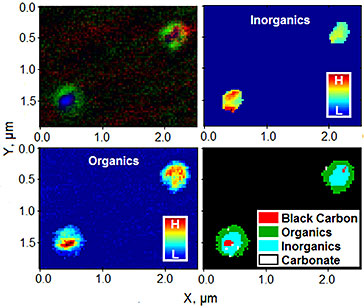Forecast Calls for Better Models: Examining the Core Components of Arctic Clouds to Clear Their Influence on Climate
Submitter:
Laskin, Alexander — Purdue University
Area of research:
Cloud-Aerosol-Precipitation Interactions
Journal Reference:
Science
Predicting how atmospheric aerosols influence cloud formation and the resulting feedback to climate is a challenge that limits the accuracy of atmospheric models. This is especially true in the Arctic, where mixed-phase (both ice- and liquid-based) clouds are frequently observed, but the processes that determine their composition are poorly understood. To obtain a closer look at what makes up Arctic clouds, scientists characterized cloud droplets and ice crystals collected at the North Slope of Alaska as part of the Indirect and Semi-Direct Aerosol Campaign (ISDAC) field study sponsored by the Department of Energy’s Office of Biological and Environmental Research (DOE-BER).
Impact
The chemical composition, mixing state, and size of individual particles and cloud droplet/ice residuals from Arctic clouds were characterized using a combination of scanning and transmission electron microscopy, X-ray analysis, and spectroscopy at EMSL and the Advanced Light Source. The work differentiated particles that serve as cloud condensation nuclei and ice nuclei from those that do not, revealing compositional differences. Cloud droplet residuals were larger than ambient particles and had characteristic organic coatings, indicating processing in clouds and coating of original nuclei with organic material. Particle composition from high ice nucleation and biomass burning plume episodes also were examined. These events had a noted effect on the number and composition of cloud-nucleating particles, e.g., showing that sodium and magnesium salts contribute to cloud nucleation due to chemical or physical characteristics. The overall analysis indicated carbonate has a chemical advantage for Arctic mixed-phase cloud nucleation over other aerosol components.
Summary
Future work involving Arctic cloud formation, particularly in understanding how either aerosol size or composition affect ice nucleation, will further improve models of cloud feedbacks and advance understanding of the impact of different types of aerosol particles on climate.


